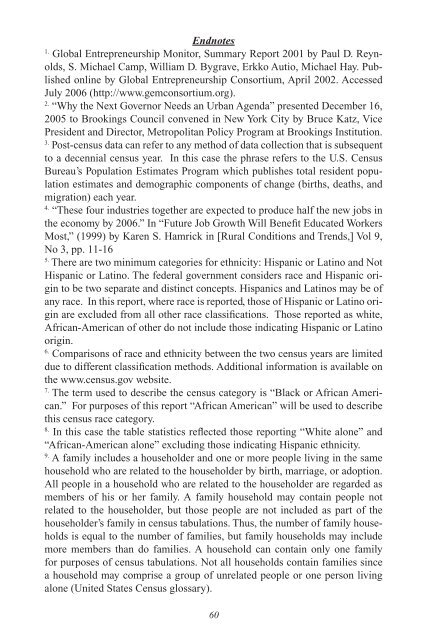Demographics - Ochs Center for Metropolitan Studies
Demographics - Ochs Center for Metropolitan Studies
Demographics - Ochs Center for Metropolitan Studies
You also want an ePaper? Increase the reach of your titles
YUMPU automatically turns print PDFs into web optimized ePapers that Google loves.
Endnotes<br />
1.<br />
Global Entrepreneurship Monitor, Summary Report 2001 by Paul D. Reynolds,<br />
S. Michael Camp, William D. Bygrave, Erkko Autio, Michael Hay. Published<br />
online by Global Entrepreneurship Consortium, April 2002. Accessed<br />
July 2006 (http://www.gemconsortium.org).<br />
2.<br />
“Why the Next Governor Needs an Urban Agenda” presented December 16,<br />
2005 to Brookings Council convened in New York City by Bruce Katz, Vice<br />
President and Director, <strong>Metropolitan</strong> Policy Program at Brookings Institution.<br />
3.<br />
Post-census data can refer to any method of data collection that is subsequent<br />
to a decennial census year. In this case the phrase refers to the U.S. Census<br />
Bureau’s Population Estimates Program which publishes total resident population<br />
estimates and demographic components of change (births, deaths, and<br />
migration) each year.<br />
4.<br />
“These four industries together are expected to produce half the new jobs in<br />
the economy by 2006.” In “Future Job Growth Will Benefit Educated Workers<br />
Most,” (1999) by Karen S. Hamrick in [Rural Conditions and Trends,] Vol 9,<br />
No 3, pp. 11-16<br />
5.<br />
There are two minimum categories <strong>for</strong> ethnicity: Hispanic or Latino and Not<br />
Hispanic or Latino. The federal government considers race and Hispanic origin<br />
to be two separate and distinct concepts. Hispanics and Latinos may be of<br />
any race. In this report, where race is reported, those of Hispanic or Latino origin<br />
are excluded from all other race classifications. Those reported as white,<br />
African-American of other do not include those indicating Hispanic or Latino<br />
origin.<br />
6.<br />
Comparisons of race and ethnicity between the two census years are limited<br />
due to different classification methods. Additional in<strong>for</strong>mation is available on<br />
the www.census.gov website.<br />
7.<br />
The term used to describe the census category is “Black or African American.”<br />
For purposes of this report “African American” will be used to describe<br />
this census race category.<br />
8.<br />
In this case the table statistics reflected those reporting “White alone” and<br />
“African-American alone” excluding those indicating Hispanic ethnicity.<br />
9.<br />
A family includes a householder and one or more people living in the same<br />
household who are related to the householder by birth, marriage, or adoption.<br />
All people in a household who are related to the householder are regarded as<br />
members of his or her family. A family household may contain people not<br />
related to the householder, but those people are not included as part of the<br />
householder’s family in census tabulations. Thus, the number of family households<br />
is equal to the number of families, but family households may include<br />
more members than do families. A household can contain only one family<br />
<strong>for</strong> purposes of census tabulations. Not all households contain families since<br />
a household may comprise a group of unrelated people or one person living<br />
alone (United States Census glossary).<br />
60



